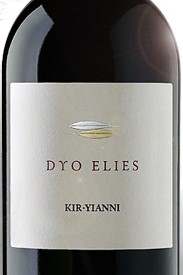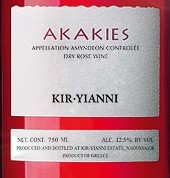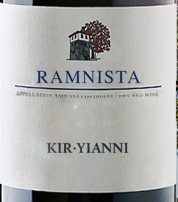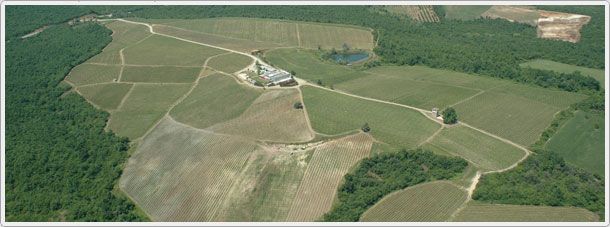
by Patrick Ogle
Kir-Yianni, was established 18 years ago when Yiannis Boutaris left the Boutari Wine Group, the premium family wine company started by his grandfather in 1879. He left the family business but he brought their history and ethic with him to the Kir-Yianni.
“The company continues a long family tradition focusing on the production of high quality wines, which combine style with authenticity and offer true enjoyment, from grapes produced at Kir-Yianni’s extensive vineyard holdings in the two wine regions of Naoussa and Amyndeon, on both sides of mount Vermio in North-Western Greece.” says Lambros Papadimitriou Sales & Marketing Director at Kir-Yianni. “Today Kir-Yianni, led by Stellios Boutaris, son of Yiannis, follows its vision into the next phase of its history , by dynamically exploiting the cornerstones of the Kir-Yianni philosophy: desire for innovation, respect for tradition and a true knowledge of the wine, from the grape to the end consumer.”
The flagship of the brand, produced in Naoussa, is Ktima Kir-Yianni (Yianakohori Hills) a xinomavro and merlot blend. The area also produces the 100 percent xinomavro wine, Ramnista and another “super-blend” Dyo Elies (xinomavro, syrah and merlot).
“In 2008, Diaporos, a single vineyard modern style xinomavro was also released. In 2011, Ble Alepou, 'Blue Fox' in English, a Bordeaux blend was launched in selected markets.” says Papadimitriou.
Kir-Yianni, was established 18 years ago when Yiannis Boutaris left the Boutari Wine Group, the premium family wine company started by his grandfather in 1879. He left the family business but he brought their history and ethic with him to the Kir-Yianni.
“The company continues a long family tradition focusing on the production of high quality wines, which combine style with authenticity and offer true enjoyment, from grapes produced at Kir-Yianni’s extensive vineyard holdings in the two wine regions of Naoussa and Amyndeon, on both sides of mount Vermio in North-Western Greece.” says Lambros Papadimitriou Sales & Marketing Director at Kir-Yianni. “Today Kir-Yianni, led by Stellios Boutaris, son of Yiannis, follows its vision into the next phase of its history , by dynamically exploiting the cornerstones of the Kir-Yianni philosophy: desire for innovation, respect for tradition and a true knowledge of the wine, from the grape to the end consumer.”
The flagship of the brand, produced in Naoussa, is Ktima Kir-Yianni (Yianakohori Hills) a xinomavro and merlot blend. The area also produces the 100 percent xinomavro wine, Ramnista and another “super-blend” Dyo Elies (xinomavro, syrah and merlot).
“In 2008, Diaporos, a single vineyard modern style xinomavro was also released. In 2011, Ble Alepou, 'Blue Fox' in English, a Bordeaux blend was launched in selected markets.” says Papadimitriou.
If xinomavro is not familiar do not worry; it is not necessarily an indication of a low wine I.Q. The grape, despite its history and pedigree, has been little seen in the United States.
“Xinomavro is the main and noblest indigenous red grape variety of northern Greece. This is a fickle variety, very difficult to grow, but very rewarding when treated right in the vineyard and at the winery, able to give terroir-driven wines, with a unique character. The name of the variety reveals its basic features: high in acidity (Xino-, sour), deep, black in colour (-mavro, black), with powerful tannins,” says Papadimitriou. “This combination of high acidity and phenolic richness results in wines with the possibility to age for many years, sometimes decades. It is also a versatile grape, able to give wines from firm, tannic red, to fragrant roses and blanc de noir, still or sparkling, dry or even sweet.”
Kir-Yianni has been in the vanguard of research, development, new cultivation and winemaking techniques in Greece—and their focus has always been on xinomavro. The grape is the cornerstone of some of the most well known Greek appellations, including PDO Naoussa and PDO Amyndeon where wines are 100 percent xinomavro. Kir-Yianni makes wine in both appellations.
“Also, the very successful rosé Akakies, the only dry PDO rosé is produced from 100% xinomavro, together with its “sibling”, Akakies Sparkling, which became an instant success as soon as it was released in summer 2012. Two red wines complete our portfolio: Paranga, the house red blend produced by grapes sourced mostly in Amyndeon, and Kali Riza, our PDO 100% xinomavro from old vines.” he adds.
“Xinomavro is the main and noblest indigenous red grape variety of northern Greece. This is a fickle variety, very difficult to grow, but very rewarding when treated right in the vineyard and at the winery, able to give terroir-driven wines, with a unique character. The name of the variety reveals its basic features: high in acidity (Xino-, sour), deep, black in colour (-mavro, black), with powerful tannins,” says Papadimitriou. “This combination of high acidity and phenolic richness results in wines with the possibility to age for many years, sometimes decades. It is also a versatile grape, able to give wines from firm, tannic red, to fragrant roses and blanc de noir, still or sparkling, dry or even sweet.”
Kir-Yianni has been in the vanguard of research, development, new cultivation and winemaking techniques in Greece—and their focus has always been on xinomavro. The grape is the cornerstone of some of the most well known Greek appellations, including PDO Naoussa and PDO Amyndeon where wines are 100 percent xinomavro. Kir-Yianni makes wine in both appellations.
“Also, the very successful rosé Akakies, the only dry PDO rosé is produced from 100% xinomavro, together with its “sibling”, Akakies Sparkling, which became an instant success as soon as it was released in summer 2012. Two red wines complete our portfolio: Paranga, the house red blend produced by grapes sourced mostly in Amyndeon, and Kali Riza, our PDO 100% xinomavro from old vines.” he adds.
The company is not only about xinomavro; they create white wines, sometime using creative blends.
“In Amyndeon the focus is on whites: Tesseris Limnes, a unique blend of chardonnay and gewurztraminer, the classic Ktima Kir-Yianni (Samaropetra Vineyard) a roditis and sauvignon blanc blend, and Petra, a roditis and malagouzia blend are produced, as well as Droumo, a very refined expression of sauvignon blanc coming from the namesake vineyard,” says Papadimitriou.
He says that roditis is one of the oldest and most widespread Greek grape varieties. It is a pink-skinned grape but is used in making white wines with aromas of ripe fruits, high alcohol content and balanced acidity. The grape is also given to genetic variation and is known across Greece in various names; each of these denoting different qualities.
“When grown in high altitude, low-yielding vineyards roditis is able to produce wines showing intense aromas and a good structure,” he says. “The mountainous vineyards of Amyndeon, with the continental climate and the poor sandy soils give one of the best expressions of this Greek indigenous grape, which is reflected in the skillful Kir-Yianni blends.”
“In Amyndeon the focus is on whites: Tesseris Limnes, a unique blend of chardonnay and gewurztraminer, the classic Ktima Kir-Yianni (Samaropetra Vineyard) a roditis and sauvignon blanc blend, and Petra, a roditis and malagouzia blend are produced, as well as Droumo, a very refined expression of sauvignon blanc coming from the namesake vineyard,” says Papadimitriou.
He says that roditis is one of the oldest and most widespread Greek grape varieties. It is a pink-skinned grape but is used in making white wines with aromas of ripe fruits, high alcohol content and balanced acidity. The grape is also given to genetic variation and is known across Greece in various names; each of these denoting different qualities.
“When grown in high altitude, low-yielding vineyards roditis is able to produce wines showing intense aromas and a good structure,” he says. “The mountainous vineyards of Amyndeon, with the continental climate and the poor sandy soils give one of the best expressions of this Greek indigenous grape, which is reflected in the skillful Kir-Yianni blends.”
With all the options available why should the American consumer look to Greek wines? For one you can experience varietals different from those you've tasted before. You will hear xinomavro called “Greece's pinot noir” but it is really its OWN varietal with its own characteristics. Papadimitriou urges people try Kir-Yianni wines for similar reasons.
“The wines of Kir-Yianni highlight the potential of the Northern Greece terroir and of its indigenous grape varieties, such as the rare red Xinomavro, with the unique aromatic character reminiscent of strawberry, cherries, tomato and olive and the Barolo-like capacity to age gracefully,” he says. “Characterful and refined, showing perfect balance in the mouth and ease of combination with various dishes of the Greek and international cuisine, these wines are among the finest examples of the emerging Greek vineyard, truly appealing to the modern consumer.”
In particular he suggests starting with Ramnista (100 percent xinomavro) from Naoussa or Akakies sparkling (100 percent xinomavro). The latter is from the mountains of the Amyndeon area which is the only appellation for sparkling wine in Greece.
The current fiscal issues in Greece have not been lost on Kir-Yianni or other Greek winemakers. In one way it has helped introduce these wines to the world and offer Greece a viable export.
“The current economic crisis has slowed down growth rate in the Greek market, but has helped all Greek wineries to focus on exports, which has led to increased sales abroad. The fact that more and more wineries show openness towards foreign markets helps producers such as Kir-Yianni, which has been an export-oriented company since very early, to spread the word about Greek wine. In the most adverse conditions, Greek wine is a promising success story that shows the way towards a creative solution to the country's economic crisis.” says Papadimitriou.
“The wines of Kir-Yianni highlight the potential of the Northern Greece terroir and of its indigenous grape varieties, such as the rare red Xinomavro, with the unique aromatic character reminiscent of strawberry, cherries, tomato and olive and the Barolo-like capacity to age gracefully,” he says. “Characterful and refined, showing perfect balance in the mouth and ease of combination with various dishes of the Greek and international cuisine, these wines are among the finest examples of the emerging Greek vineyard, truly appealing to the modern consumer.”
In particular he suggests starting with Ramnista (100 percent xinomavro) from Naoussa or Akakies sparkling (100 percent xinomavro). The latter is from the mountains of the Amyndeon area which is the only appellation for sparkling wine in Greece.
The current fiscal issues in Greece have not been lost on Kir-Yianni or other Greek winemakers. In one way it has helped introduce these wines to the world and offer Greece a viable export.
“The current economic crisis has slowed down growth rate in the Greek market, but has helped all Greek wineries to focus on exports, which has led to increased sales abroad. The fact that more and more wineries show openness towards foreign markets helps producers such as Kir-Yianni, which has been an export-oriented company since very early, to spread the word about Greek wine. In the most adverse conditions, Greek wine is a promising success story that shows the way towards a creative solution to the country's economic crisis.” says Papadimitriou.




 RSS Feed
RSS Feed